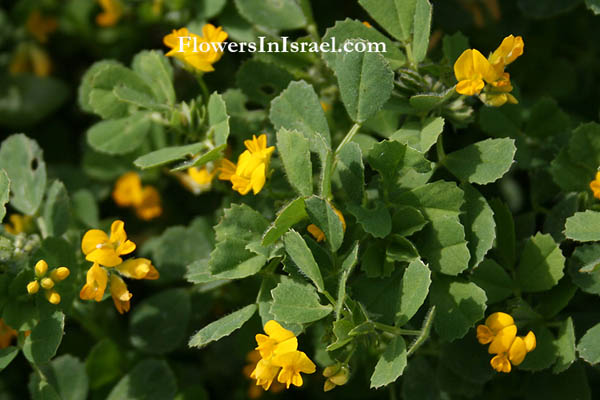Bur Clover, Burr medic, Toothed bur clover, Toothed medick,
Hebrew: אספסת מצויה, Arabic: الفصة متعددة الأشكال, Egypt: نفل "Nafal"
| Scientific name: | Medicago polymorpha L. | |
| Synonym name: | Medicago hispida Gaertner, Medicago denticulata Willd. | |
| Common name: | California burclover, Bur Clover, Burr medic, Toothed bur clover, Toothed medick | |
| Hebrew name: | אספסת מצויה | |
| Arabic name: | الفصة متعددة الأشكال | |
| Egypt: | نفل "Nafal" | |
| Plant Family: | Papilionaceae, פרפרניים |

|
| Life form: | Annual | |
| Stems: | 45-60 cm high; erect, prostrate or ascending, branched at base, subquadrangular, hairless | |
| Leaves: | Alternate, compound, trifoliate, dentate or serrate | |
| Inflorescence: | Raceme, axillary, 2–6-flowered | |
| Flowers: | Yellow, pea-like flowers, calyx ± 3 mm; corolla 3.5–6 mm, standard obovate, emarginate | |
| Fruits / pods: | Flattened, coiled pod | |
| Flowering Period: | March, April | |
| Habitat: | Batha, Phrygana | |
| Distribution: | Mediterranean Woodlands and Shrublands, Semi-steppe shrublands, Shrub-steppes, Deserts and extreme deserts, Montane vegetation of Mt. Hermon | |
| Chorotype: | Euro-Siberian - Med - Irano-Turanian | |
| Summer shedding: | Ephemeral |

Derivation of the botanical name: Medicago, from Medike, or medick, the Greek name for alfalfa, which came to Greece from Medea. polymorpha, polymorphos, πολυμορφοϛ, multiform; taking many forms, variable. hispida, rough, shaggy, bristly. denticulata, denticulate, with very small teeth. The Hebrew name: אספסת, aspheset, Aramaic-Syrian: אספסתא; from Persian ispist, isjist, whence also Arabic isfast.
|